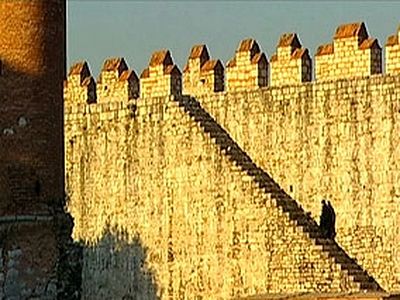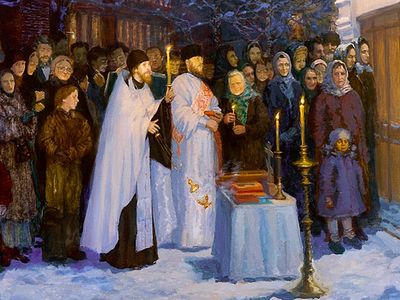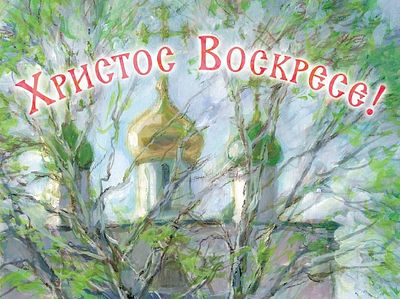The history of Sretensky Monastery—its apogee, its desolation in the twentieth century, and its rebirth at the end of an era, in the early 1990’s—is rich and diverse. But we can always find the Lord’s instruction in whatever might happen. Here are just a few incidents from the monastery’s recent history.
Elder John’s instructions
 Archimandrite Tikhon (Shevkunov)
Archimandrite Tikhon (Shevkunov)
The story of the Pskov-Caves Monastery metochion’s coming into existence in Moscow is rather remarkable. It is connected with the name of an extraordinary man, a Godly ascetic of the twentieth century, Fr. John (Krestiankin). I will even dare to say that the Spirit of God was with him.
I must note that His Holiness Patriarch Alexy II had forbade the opening of metochia in the nation’s capital by any monasteries that were not stavropegic [having the Patriarch as ruling bishop]. This was during the years 1992 and 1993, when many monasteries were being returned to the Church, when monastic life was reviving in monasteries throughout all of Russia; and each one would have liked to have it’s affiliate in the capital. If this had been allowed, then all the parish churches in Moscow would have become monastic metochia, and there would have remained but few parishes, or none at all. That is why Patriarch Alexy stated at one of the diocesan meetings that there would be no diocesan metochia in Moscow. But the Pskov-Caves Monastery opened its metochion in Moscow. Here is how it happened.
Just then, in 1993, I had come to Pechory to see Fr. John (Krestiankin). This was a difficult time in my life, and I needed Fr. John’s advice and spiritual support. We talked together in his cell, and Batiushka said to me, “Go to the church (it was a feast day, and they were reading the akathist), we will meet each other there.” So we stood in the altar of the Church of the Dormition in the caves—Fr. Joasaph, Fr. Philaret, and I. Suddenly Fr. John came up to me unexpectedly, took me by the arm, led me to the Holy Table, and said, “Now listen to the will of God.” This was totally unexpected, because Fr. John never used such strong words. “You should return to Moscow. Go to His Holiness the Patriarch and ask him to transfer you from Donskoy Monastery to the Pskov-Caves Monastery. You will found our metochion in Moscow.”
This shook me to the core. How could this be? A monk’s spiritual father tells him to transfer from one monastery to another?! Those who know even a little about monastic life would understand how unthinkable this is. But here was an elder, Fr. John, saying such a thing. And what metochion could be opened, when everyone knew the Patriarch’s statement on the subject? He had, moreover, stated it quite sternly, so that no one would even try.
I tried to tell Fr. John, “Batiushka dear, the Patriarch was very tough about the metochia, and I am afraid to approach him with such a request.” But Fr. John replied, “My dear, do what I tell you to do.” Now, Fr. John rarely spoke like this. He would usually say, “I advise you to do such and such.” But now he was saying clearly and precisely, “Listen to the will of God. You will go to His Holiness and see that he will only be glad, and will say, “Yes, do it.” Do not accept the first church they offer you, nor the second. Take the third church.”
I left absolutely shaken. But what was there to do? I had to ask, regardless of my infirmity, for I feared Fr. John more than I did the Patriarch.
So, I returned to Moscow, and at a service where the Patriarch was serving, I approached him. Trembling with fear, I uttered the phrase I had carefully studied so as not to mix things up: “Your Holiness, bless me to transfer to the Pskov-Caves Monastery and found its metochion in Moscow.” I stammered out the words, and then froze in horror. But out of nowhere His Holiness the Patriarch said, “Fr. Tikhon, that is very good. Yes, yes, yes—it’s quite needed, really, quite needed. Vladyka Arseny [Patriarch Alexy’s diocesan assistant], come here.” Bishop (now Archbishop) Arseny of Istra came forward. The Patriarch said to him, “Work on this. You see, the monastery is on the Estonian border.” They had only just designated that border, and everyone thought that there would be a border zone of five kilometers where no one would be allowed to go. “We will make metochia for Pukhtitsa Convent [which is in Estonia], and for Pskov-Caves Monastery,” said the Patriarch. “Truly, it’s necessary; people won’t have access to those monasteries, it will be too complicated. Do it.” This was the fear in those days.
Vladyka Arseny called Fr. Vladimir Divakova; they began to discuss which church to give us for a metochion, and told me how I should transfer. Things were happening so quickly that I could scarcely believe it. And I was not the only one—everyone else including Bishop Arseny were all amazed, because they had been present when the Patriarch declared that there would be no diocesan metochia in Moscow. Even now there are none. The Pskov-Caves monastery was the only exception.
They offered me the Protection Monastery for a metochion. But I remembered Fr. John’s instructions, “Do not take the first, big one. Take the small one.” When I saw the Protection Monastery, I thought, “Oh! It’s so big! No, I won’t take it.” I went to Vladyka Arseny and told him that it is not suitable. He said to me, “Well, aren’t you picky! Go then to Ismailovo.” There was a church on an island there, a beautiful church. I liked it very much—isolated, near a forest, surrounded by water, and comely. But I remembered that Batiushka John had told me not to accept the second one, either. I thought, “What did he mean? But since that is what he said, that is what I need to do.” Again I went to Vladyka Arseny, again I told him that this church is not suitable. He answered, “Since the beautiful churches don’t suit you, take an ordinary one. Go to Lubyanka Street.” I went there, and then called Fr. John through Fr. Philaret [his cell attendant]. Of course, Fr. John did not have a telephone, but Fr. Philaret already had a mobile phone by that time. I told Batiushka about Sretensky Monastery. He asked, “Is that the one next to Trubnaya Square? Take it, take it.” And that is how the Sretensky Monastery began its restoration.
We had our first church services on the feast of the Meeting of the Lord. There were many people, and even more complications. We served vigil outdoors. Fifteen years later we served the litia again outdoors in remembrance of that first occasion. However, fifteen years ago it was 25 degrees below (C.) zero outside. But no one got sick, and it all went well, glory be to God. After all, if you trust the Lord, everything always works out for the best, by God’s Providence.
“Now lettest thou Thy servant depart…”
The Bolsheviks closed Sretensky Monastery in 1925. Holy Hierarch Hilarion (Troitsky), a brilliant theologian, unsurpassed orator, and a courageous and faithful confessor of Christ, was one of the last of the monastery’s abbots. Although Vladyka Hilarion headed the monastery for less than a year, he did much for it as well as for the whole Russian Church during that brief period of time. After all, when Patriarch Tikhon appointed Bishop Hilarion—he was a close assistant to the Patriarch—as abbot of Sretensky Monastery with an elevation to the rank of archbishop, the monastery was in the grips of the renovators. This was one of the centers in Moscow of renovationism. St. Hilarion returned the monastery’s brothers and parishioners, who had been deceived by the renovationists’ cunning speech, to the bosom of the true Church; he accepted their repentance, and re-consecrated the Holy Table, the altar, the church, and the entire monastery. This was a cleansing of all the defilement of false teaching, and the spiritual renewal of the monastery.
St. Hilarion never doubted that God’s Church would withstand everything, although he saw how monasteries and churches were being closed and razed all over, how clergymen were being thrown into prison and murdered, and how the Orthodox laity was being persecuted. The saint carried along his thorny path of trials and torments to the end his belief, steadfastness, and hope that the Lord will not abandon His faithful. He instilled these spiritual qualities in his spiritual daughter, Liubov Timofeevna Cheredovaya.
Liubov Timofevna was a spiritual daughter of St. Hilarion. She first met him when she was twenty-six years old. In 1929, Vladyka Hilarion departed to the Lord as a martyr and confessor. He died in Petrograd, in a transit prison, from a serious illness brought on by prison and the camps. He was in the transit prison on the way from Solovki to Central Asia, where he was being taken under guard to finish off his prison term. Only a few people came from Moscow to his funeral, amongst whom was Liubov Timofeevna. She was thirty at the time. In place of the handsome giant they once knew, they saw in the coffin a bent old man, completely gray. That is what the tortures and camps had done to him. All her life, Liubov Timofeevna was absolutely sure that Vladyka Hilarion was a great intercessor before the Lord, a saint, a hieromartyr and confessor. And she said many times that she would not die before Vladyka Hilarion had been canonized.
I have to add that when Sretensky Monastery was being restored and Liubov Timofeevna began to come to the services, she was already 100 years old! But she firmly believed that Vladyka Hilarion would be canonized while she was still alive. The Monastery was just beginning to gather materials for the glorification of Hieromartyr and Confessor Hilarion (Troitsky) and had written his Life for presentation to the canonization committee of the Holy Synod. Liubov Timofeevna, by the way, told us many interesting things about the saint, and gave us many of his photographs.
The canonization committee works long and scrupulously; it could not be otherwise, for many facts and circumstances must be proven, especially concerning the martyrs of the twentieth century. It was the same for the material about Archbishop Hilarion. The material on his life was reviewed during the course of over two years at several committee meetings, but a final resolution had not yet been made. Liubov Timofeevna had reached the age of 100, then 101, and was now experiencing serious, exhausting illnesses; nevertheless, she still lived with the firm belief that Hierarch Hilarion would be canonized, that it would happen during her earthly lifetime, and that she would hear what she had believed all her life, never doubting. The doctors were amazed at how she could still be alive with all her illnesses. But Liubov Timofeevna would only say, “I will not die until I hear the resolution to canonize Hieromartyr Hilarion.” Her faith lent support to our own faith and sureness. We had even painted a small icon of Hieromartyr Hilarion, only without his name, and hung it on the royal doors of the church’s side altar.
Then, in early March, 1998, Metropolitan Juvenaly, the committee chairman, called us to say that the final committee meeting dedicated to the canonization of Vladyka Hilarion was scheduled for March 11. He said that all the necessary documents had been collected, all the evidence was with the committee, that the archives had arrived from the Cheka which testified to Vladyka Hilarion’s conduct during interrogation—he was courageous and steadfast, did not betray anyone, and adamantly preserved his own faith. Vladyka Juvenaly also told us that the commission was ready to confirm Archbishop Hilarion’s canonization on that day, March 11. We went straight to Liubov Timofeevna to tell her the news. She was already very weak and sick; she was then 102 years old. She received Holy Communion; and although in her physical weakness, the words “Now lettest Thou Thy servant depart in peace, O Master, according to Thy word…” were not on her lips, they were certainly in her heart.
Several days passed. Liubov Timofeevna’s condition got worse and worse. She lost consciousness, and Fr. Nicander came to commune her for the last time. She died on March 9. She was buried on the third day, March 11, according to Orthodox Christian practice. Her funeral was served in our monastery at about 11:00 a.m., after the Liturgy of the Presanctified Gifts. That was the very hour in which the committee meeting was taking place, when the resolution was being accepted to canonize Hieromartyr and Confessor Hilarion (Troitsky), Archbishop of Verea, Abbot of Sretensky Monastery. On the day and in the hour when the Holy Church conducted slave of God Liubov from this earth and read the prayer of absolution for her, it read it as if from the lips of her spiritual father, Vladyka Hilarion.
Here is another interesting fact: the coffin holding slave of God Liubov’s body stood all night and a day before the very icon of Holy Hieromartyr Hilarion that we had prepared for his canonization, with no name, and hung on the column to the right of the royal doors of the side altar. No other church had an icon of St. Hilarion. This all happened as if by chance—Liubov Timofeevna’s body could have been taken to another church to have the Psalter read over her, especially since it is not customary to leave corpses in monastery churches for funerals. We had made an exception in this case, since she had no living relatives. Even her friends had offered to take her to other churches that she had often visited while alive, such as the Yelokhovsky Cathedral, for example. But circumstances had it that we would bring her to our church and place her in the small side chapel. And she lay there all night and day before the icon of her spiritual father, Vladyka Hilarion (Troitsky). This is how the Lord consoles and saves His faithful cross-bearers—people who hope steadfastly in Him and in His truth.



